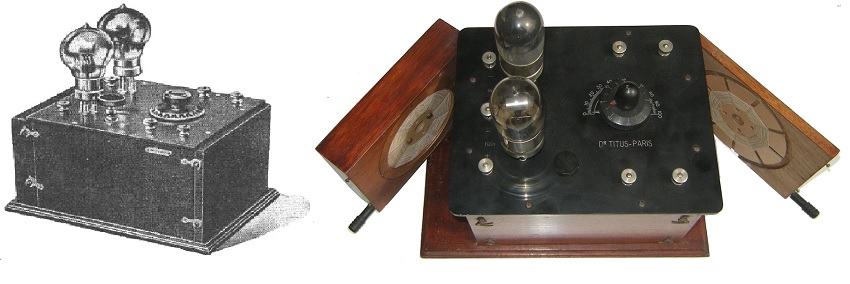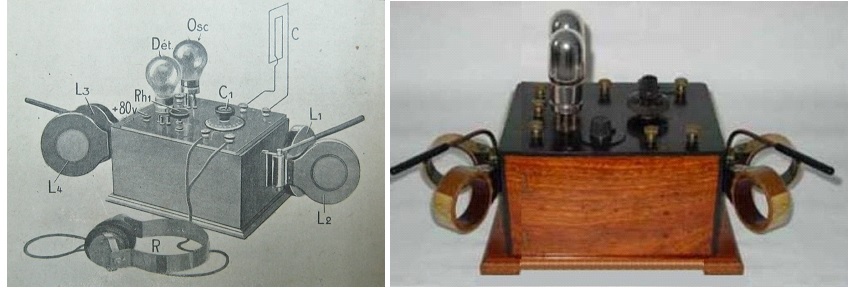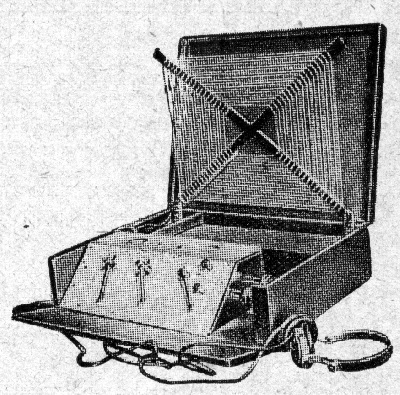TITUS KONTESCHWELLER
TITUS KONTESCHWELLER

TITUS KONTESCHWELLER
Brief Historical Background
Titus Konteschweller was born at the end of the 1890s, elder son of the pharmacist Eduard Konteschweller. After graduating the high school in Craiova (his native town in south-east Romania) he leaves for Paris to study medicine. Taking his doctor degree he settles in Paris as a physician, already known since 1918 in French medical circles as the one who introduced the word “pyreotherapy” into the medical language.
At the beginning of the twenties his younger brother Mihail Konteschweller arrives also in Paris to study electrical engineering. At the beginning of the broadcasting era in France, as the most part of the young generation, the two brothers develop a passion for radio-technique.
The 27th of June 1922, Mr. Edwin Howard Armstrong applies and is attributed (in less than a month), the 25th of July the patent for super-regeneration. (“Signaling system", US patent 1424065)
A few months later, on the 14th of November 1922, Mr. Edwin Howard Armstrong holds in Paris a public conference followed by a practical demonstration, introducing the Super-Regeneration to the French public, at the invitation of the French amateurs “Les Amis de la T.S.F.”
The conference and following demonstration triggers the enthusiasm of many French amateurs who start experimenting with the new principle. However, (as stated in the newspapers of the time) the circuit being not so easy to understand and to master, the big majority soon looses interest, and after a while, only a very few (the real “connoisseurs”), continue to advocate and use the super-regeneration.
Most probably the Konteschweller brothers attended the conference and surely Titus obtained a licence to manufacture super-regenerative sets in France. In the fall of 1923 Dr. Titus Konteschweller establishes the company DR. TITUS PARIS entirely dedicated to manufacturing super-regenerative radio sets.
The Company “DR. TITUS”
Disclaimer: In this presentation we do not intend to negate or minimize the contribution of the younger brother, Mihail Konteschweller, to the achievements of the company. We are convinced that Mihail’s training as an electrical engineer brought a major contribution to the professionalism of the enterprise. But for obvious reasons Konteschweller brothers chose Titus as the leading figure in Paris. As a consequence, all the technical articles and advertising from the French newspapers of that time, which guided us in writing this text, are mentioning him alone. We do believe we respect their choice by doing the same. The reader will know that we mean both Titus and Mihail Konteschweller although we mention only the first, in order to stay true to our sources of information.
Dr. Titus Konteschweller belonged to those very few who really mastered the theory and the practice of the super-regeneration. He is (to our knowledge) the only “Radio Amateur” of that era that reached the status of “Radio Manufacturer” becoming the best known manufacturer for super-regenerative radio sets in France.
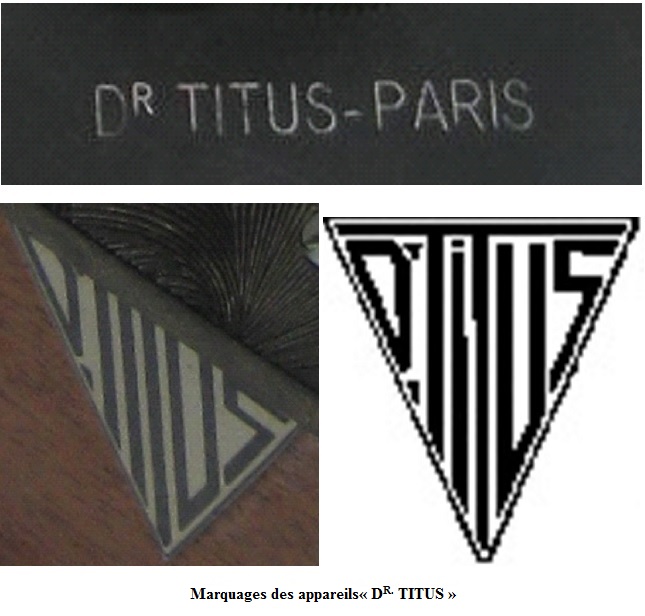
Markings and logo on DR. TITUS’ sets
The markings on the manufactured sets vary from plain engravings “DR. TITUS-PARIS” on the panels to a logo containing styled in a triangle the words “DR. TITUS”.
Articles in technical papers and advertising published in technical magazines prove the existence, between 1923 and 1930, of the company “DR TITUS”, specialized in manufacturing only super-regenerative receivers belonging to Dr. Titus Konteschweller rue Wattignies, Nr. 69, Paris XII:

Advertising published January 1924 in the magazine “La Science et la Vie”
Circuit Diagrams of “DR. TITUS’”
First Set (The Basic Circuit Diagram)
The circuit diagram of the first set (the basic circuit diagram) is to be found, in the magazine “La Nature” from 1925 in an article by P. Hemardinquer with the legend: ”Super regenerative circuit with 2 valves, the first detector, the second oscillator using the variation of the positive resistance (DR. Titus’ circuit)”
The circuit diagram “Dr. Titus” from “La Nature” 1925.
The radio waves collected by the loop antenna and selected by the variable capacitor C1 are sent through the detection group R1 C2 on the grid of the first valve - the super-regenerative detector (Dét.). The coils L1 and L2 respectively in the grid and plate circuit of the first tube are magnetically coupled to produce strong regeneration. The headphones (R) with the parallel capacity (C3) close the plate circuit to the positive pole of a plate (B) battery delivering 80 to 120 V. The filament is heated through the rheostat Rh1 (having also the role of a circuit breaker), from a 4 ÷ 5 V storage (A) battery.
The second valve- “Oscil.” together with the grid resonant circuit L3 C4 and the plate regeneration coil L4 (“tickler”) form the quenching oscillator. It produces the low frequency signal (8 kHz) which is applied on the grid of the first tube before the detection (grid leak) circuit (R1 C2) interrupting periodically the exponential growth of oscillation in the super-regenerative detector. Both tubes use the same plate and filament batteries and the same rheostat.
There are two (slightly antagonistic) principles governing the performance of super-regenerative receivers:
1. The gain is inverse proportional with the difference between the received and quenching frequency. That is, for maximum gain one should choose the lowest quenching frequency one can afford.
2. The Nyquist-Shannon principle shows that for retrieval without distortion of a signal, the theoretical lower limit of the sampling frequency should be (at least) the double of the highest frequency in signal’s spectrum.
Nowadays one chooses the quenching/sampling frequency slightly above the hearing range using mostly a self-blocking quenching oscillator working on the same active device as the super-regenerative detector. That makes super-regeneration usable only with short and ultra short waves. On the twenties, with the available loudspeakers, using separate sinusoidal quenching oscillators one could afford to lower the quenching frequency towards 8 – 12 kHz without punishing too much the ears of the audience.
Titus Konteschweller choosing a quenching frequency of 8 kHz (sometimes slightly lower) succeeds in obtaining with only two valves and small loop antennas, loudspeaker level from remote transmitters.
Edwin Howard Armstrong using quenching on 10 – 12 kHz for his demonstration set in 1922 had to add an AF stage to reach loudspeaker level:
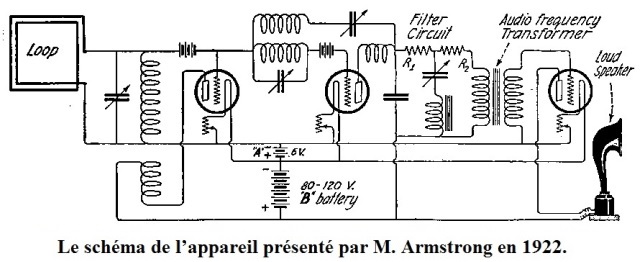
Circuit diagram of Mr. Armstrong’s demonstration set 1922
The Super-Modulator
Trying permanently to improve the quality of his sets, Titus Konteschweller invents and publishes the concept “Super-Modulator” combining frequency change with super-regeneration:
The Super-Modulator DR. TITUS circuit diagram and the experimental set-up.
The first two valves are (respectively) the modulator (A) and the local oscillator (B) of a frequency convertor (Ultradyn) transforming the incoming long or medium waves in an intermediate frequency, higher as the one received, somewhere in short waves’ range. The last two valves are the super-regenerative detector (C) and quenching oscillator (D). The resulting set combines on all wavelengths the characteristic high gain of the super-regeneration with super-heterodyne selectivity and higher fidelity (due to the increased sampling frequency).
According to our information, the super-modulator (due probably to the lack of proper licenses) has not reached production stage.
Titus’ Ultra-Regeneration
Titus Konteschweller adds another valve as tuned radiofrequency amplifier in the regeneration loop of the super-regenerative detector which substantially increases gain and selectivity. Actually he named this new receiver “Ultra-Regeneration”, unaware the name was already used by Lee De Forest. We choose to rename it Titus’ Ultra-Regeneration to avoid confusion.
The tubes “A” and “C” are (respectively) the super-regenerative detector and the sampling oscillator. The “B” tube is the tuned radiofrequency amplifier meant to improve the gain and selectivity.
Single-valve receiver
Using a double-grid valve (spatial charge grid valve = bigrille)

Single valve receiver super-regenerative set using Numans-Roosenstein’s oscillator
The radio waves collected by the loop antenna (in fact a 15 cm diameter “Gabion” coil) and selected by the variable capacitor 0.5/1000 µF are sent through the coupling capacitor 0.2/1000 µF on the second grid of the valve, the resistor 2 [M]Ω providing the correct bias. The current of the first grid is injected (by the direct connection specific to the Numans-Roosenstein oscillator) into the tuned input circuit and produces regeneration. The input circuit oscillates on the received frequency. The inductance L tuned by its parallel capacitor C (2/1000 µF) on a lower frequency constitutes the quenching oscillator, cutting regularly the input circuit oscillations. like in all super regenerative receivers. The headphones with the parallel capacitor (10/1000 µF) are closing the plate circuit to the positive pole of a 16 - 24 VDC battery. The filament is heated by a 4 V accumulator through the 30 ω [30 Ω] rheostat provided also with a circuit breaker.
Small modifications in the basic circuit diagram
Some minor modifications appear with the passing of the years:
In 1926 Mihail Konteschweller (Titus’ younger brother) publishes in Romania in the magazine “Radiofonia” (The Radiophony) the basic circuit diagram. One notices an extra capacitor C5 in parallel with the quenching oscillator tickler L4:

Circuit diagram published in 1926 in Romania
In order to gain more space inside a portable set in 1927, L3 and L4 are wound together on a single former, the control of the quenching oscillator is made by a second rheostat and by varying the taps on the anode battery. Also because the audition was made in headphones, a filtering LC was installed in parallel to diminish the super-regenerative whistle.

Circuit diagram published in 1927 in Radio News
Dr. TITUS’ Receiver Sets
Disclaimer: We were not able to find a printed catalogue or a reliable list containing all the types of sets manufactured by “DR. TITUS”. We can only bring to your attention our attempt to systemize information gathered from articles and advertisements published in the newspapers and magazines of the time. We also used information provided by the actual collectors or collector’s associations, therefore the dates of manufacturing and release on the market, could not always be set accurately. (There are still collectors “over-aging” their collected items whether knowingly or not.)

If somebody has this catalogue or knows where it could be found, please give us notice!
STATIONARY SETS
“Classical” Design
1924 Single-valve receiver
Super-regenerative set equipped with a double-grid valve using Numans-Roosenstein’s oscillator. Only one interchangeable coil used as loop antenna. Theoretically it could receive all wavelengths. (Only by changing the coil)
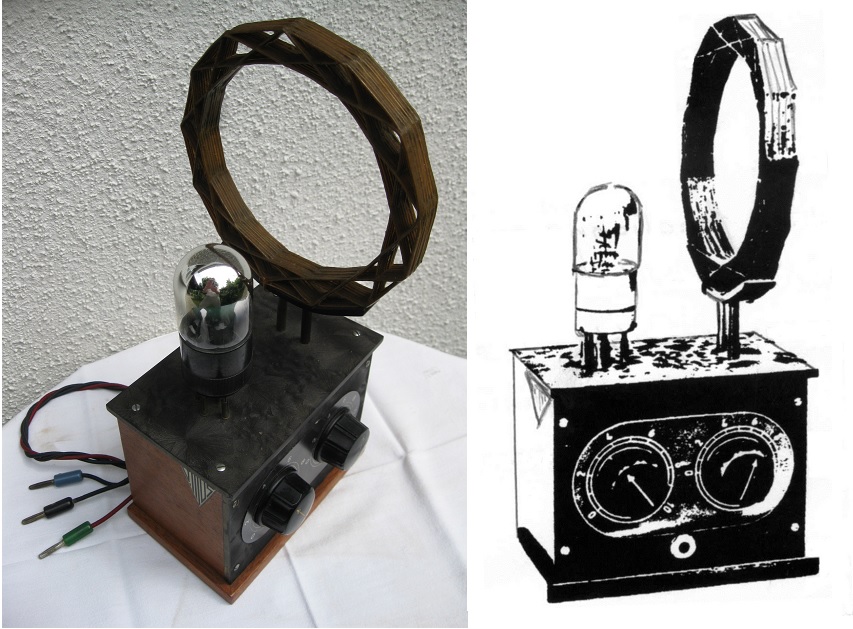
1923 “Ordinaire”(The first set)
The first set using the basic circuit diagram. L2 and L4 are in the lateral flaps. It receives only middle waves.
:
“Ordinaire” Only MW. The first set DR. TITUS 1923
As stated in the later advertising it will be also manufactured in the following years, and in order to be distinguished from the newer models it is named “modèle Ordinaire”
1924 “Normal”
The set is using the basic circuit diagram. L4 is in the lateral flap, L2 is movable and both L1 and L2 interchangeable. Theoretically it could receive all wavelengths.
“Normal”. All Wavelengths DR. TITUS 1924
In the later advertising it will be named “modèle Normal” in order to be distinguished from the other models.
1924 “Universell”
The set is using the basic circuit diagram. L1, L2, L3 and L4 are interchangeable. L2 and L4 are movable. It receives all wavelengths and allows the changing of the quenching frequency.
“Universell”. All Wavelengths. Variable Quenching. DR. TITUS 1924
In advertising it is named “modèle Universell” in order to be distinguished from the other models.
“Cabinet” Design
Around 1925 -26 the French market is invaded by American receivers bringing a new design. All components are “hidden” inside a cabinet, only the controls and the binding posts are visible. Titus Konteschweller starts putting his receivers in cabinets.
1926 “Coffret à deux lampes” (Cabinet with Two Valves)
The set is using the basic circuit diagram.
1926 Coffret à trois lampes. (Cabinet with Three Valves)
The set is using the Titus’ Ultra-Regeneration circuit diagram.
PORTABLE SETS
1924 “Camping”
The set is using the basic circuit diagram.
DR. TITUS’ Camping 1924.
A suitcase measuring 14 X 35 X 50 cm contains everything: loop antenna, receiver batteries and headphones. (Together with the storage (A) battery it weighs 10 - 11 kg)
The set enjoys a big public success. (Too big maybe.) It is said that the first prototype displayed at 1924 “Foire de Paris” (the Paris Fair in 1924) disappeared in broad daylight from the stand it was exhibited!
1927 “Portable”
The set is using the circuit diagram published in 1927 in Radio News.
Lighter and smaller than “Camping”, the suitcase containing all the peripherals measures only 29 X 25 X 13 cm, and weighs 4.5 kg. It is exhibited with success at “Salon TSF 1927” then it becomes the “Grand Prix” at Liège 1927 and finally wins the first prize at the super-regenerative receiver contest organized by the New York magazine “Radio News” in the same year.
Best regards,
Leverkusen 18.01.2017
Pitagora Schorsch
Pièces jointes:- DR TITUS Marquages (85 KB)
- DR TITUS Reclame (103 KB)
- DR TITUS Schema 1 (61 KB)
- DR TITUS Armstrong (60 KB)
- DR TITUS Supermodulateur (74 KB)
- DR TITUS Ultrareaction (104 KB)
- DR TITUS Monolampe 1 (219 KB)
- DR TITUS Schema 2 (80 KB)
- DR TITUS Radio News 1 (46 KB)
- DR TITUS Monolampe 2 (183 KB)
- DR TITUS Bilampe 1 (71 KB)
- DR TITUS Bilampe 2 (104 KB)
- DR TITUS Bilampe 3 (75 KB)
- DR TITUS Cofret 2 (112 KB)
- DR TITUS Cofret 3 (89 KB)
- DR TITUS Portable 0 (26 KB)
- DR TITUS Portable 1 (78 KB)
- DR TITUS Portable 2 (54 KB)
- DR TITUS Camping (100 KB)
Remerciez l'auteur car vous trouvez que ce message est utile ou bien construit.



